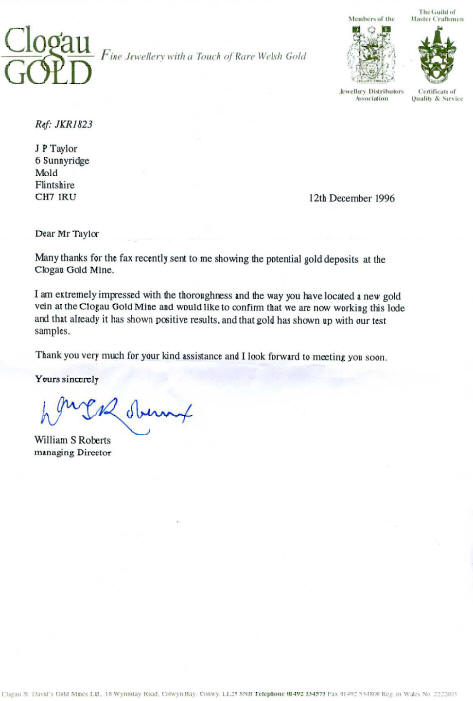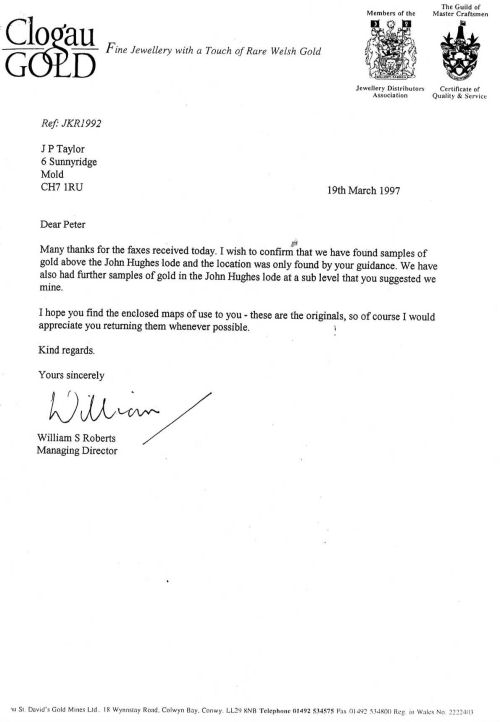 |
GOLD PROSPECTING Global Discovery, Natural Gold, Diamonds & Precious Metals Prospecting Professional |
|---|
GOLD MINES IN WALES
All Minerals, Gold and Silver Surveying Worldwide


Many people think that the gold in Wales has finished but
they could not be more wrong. I myself has worked in the gold mines
in Wales as I spent quite some time tracking and finding gold in the
Clogau Gold Mine in 1997 assisting in locating natural gold within
the rock formations. As you will see when you look at the
testimonials on this site I did find gold for the Company at the
time. I also spent some time before it closed in the Gwynfynydd Gold
Mine so I have got some experience regarding the Welsh gold.
The difference between Welsh gold and the rest of the World is
the colour, the colour of Welsh gold is a yellow/green whereas the
worlds gold is a more butter colour gold. There is also a high value
in Welsh gold compared with the World gold. It can be valued at
three times greater than the Worlds gold fortwo reasons, (1) is of
its colour and (2) because Welsh gold is so rare and hard to find
and this is why I wanted to learn and find out how to find this type
of gold because of its rareity and difference.
Regarding
previous production of Welsh gold there has been a real high
production taken from mainly two of the gold mines, although there
were many small ones they had to survive on the alternative minerals
which the gold would be amalgamated, such as copper and led, within
this part of the world.
Clogau Gold Mine
I started work at Clogau Gold Mine in 1996/97.
In the Clogau Gold Mine it was known that if you hit what is
known as silver led you are not far off hitting the Welsh gold
itself. I learnt this in 1996 when I worked in the mining tunnel
called John Hughes Load . The geologist in 1905 said to the managers
of the Mine at that time that there was no gold at the face of the
tunnel in that part of the mine as the geology had changed which
meant that there would be no gold but in those days they did not
have a professional person like myself with the sensitivity to pick
up the gold with the techniques that I use.
In 1996 I did
find the gold in the John Hughes Load and the reason why they missed
it in 1905 at the face of the John Hughes' Tunnel was that the
geology had changed because the earth movement had changed and
created a fault which had dropped the gold below the existing tunnel
face into a different position just 2 feet below the floor of the
face of the tunnel within the mine I come across the silver led
which indicates the gold will not be far from it at which time I
informed the Mining Company that this was the place for them to
proceed and dig downwards which they did and found the gold which
lasted them for 9 months of continuous extracting. During my time at
Clogau near where they called it “number 2 Shaft” I did guide the
miners to find another location of gold which turned out to be a
gold pod, for those of you who may not know what a gold pod is it is
like an explosion of gold from the centre exploding out from the
quartz so the density of the gold is in the centre and spread out
like a star, in this case the amount of gold found was about 250ozs
to 260ozs from the pod. About a year later sadly they closed the
mine but has now re-opened with a different company.
And
even today there is still plenty of gold in Wales if you know where
to look to find it.
Gwynfynydd
Gold Mine
I then continued my work to find further
gold for them but this time in Gwynfynydd Gold Mine but
unfortunately I was only there for a short time as unbeknowns to me
they were closing this mine but what I can say is that in the time I
was there I did pick up or should I say locate potential gold areas
or pods inside the mine and also by what I call “remote viewing”
which is working on maps of the site and this was done on both
sites.
In today's world with out modern technology we have
today with computers and with Google earth I can survey a site
anywhere in the world remotely and quickly and fairly accurately to
test with m y tools to see if there is gold in that part of the
world. It is slightly different to the map surveying but the
princple is the same, we connect to that part of the world and then
go to that part of the world to confirm the site, this is what I did
in the Clogau Gold Mine and the Gwynfynydd gold Mine all those years
ago but I did it with ordnance survey maps in those days.
Professional gold consultant
with full references from genuine Gold Mine companies
Why would there be gold left in a mine?
Very often in days gone by the miners would have found a seam of gold, followed it so far, and then they would lose it.
This is because the geology had changed and very often they would make several attempts to locate it but because of the geological faults and structures they would be unable to find the gold
So some of the old gold mines will still carry gold which would be profitable in today's market. These can be located by someone like myself by doing a remote survey then follow up with a site visit.
Fracture zones or Shatter zones can carry gold also.
Using the map search results as a guide I conduct a site survey above ground. If there is any old mine adits (tunnels) on the site I would go inside to see where the seams of gold could be in the old mine workings
When checking inside the mines it is different to checking above ground as you are restricted to the area you have got inside the mine and it is also darker but it can be done and I have done it previously.
It is possible for me to indicate on site more accurately the size of the gold and precious metal including platinum and diamond deposits. It is also possible for me to estimate the quantity of gold or precious metals within the quartz veins and surrounding rocks, possibly the quality as well. All these points can be confirmed by the geologist as well as the field consultant on results. Thus giving a more accurate finding by using both the field consultant and the geologist.
